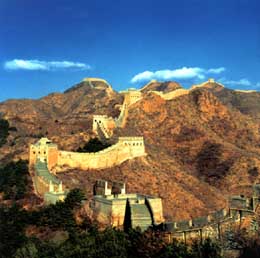| Tools: Save | Print | E-mail | Most Read |
| The Great Wall |
| Adjust font size: |
From Shanhaiguan, northeast of Qinhuangdao City, Hebei Province in the east coast, the Great Wall rises and falls with the contours of the mountains westward, crossing nine provinces, municipalities and autonomous regions for 6,700 kilometers, to end at Jiayuguan, southwest of Jiayuguan City in Gansu Province. The construction of the wall began during the Spring and Autumn period (770-476 BC) and Warring States period (475-221 BC) during the Eastern Zhou Dynasty. Ducal states at that time built walls to defend their own territories. After the First Emperor of the Qin Dynasty crushed all rival states, he founded the first centralized and unified dynasty in Chinese history. To consolidate the country and ward off invasion by ethnic minority tribes in the north, he had the walls linked and extended, giving rise to the 5,000-kilometer-long Qin Great Wall. Later dynasties from Han (206 BC – AD 220) to Ming (1368-1644) kept building and improving the wall, extending it more than 1,000 kilometers to today's scale.
The Great Wall we see today mostly dates back to the Ming Dynasty. The best-preserved and most imposing section is at Badaling in Beijing. The section, located outside the Juyongguan Pass, is made of large blue bricks and has an average height of 7.8 meters. Five to six horses can be ridden abreast along it. At regular intervals there is an arched door leading to the top of the wall. The walls are covered with many lookout holes, window embrasures and castellated crenels. Beacon towers were also built at fixed intervals for passing on military information. All these indicate the important role of the Great Wall in military defense. As one of the most magnificent ancient defense works, the Great Wall was put on the world cultural heritage list in 1987. Badaling Great Wall Address: Yanqing County, 70 km from Beijing's city proper; Juyongguan Great Wall Address: North of Changping, government seat of Changping District; Simatai Great Wall Address: Gubeikou Town, Miyun County; Jinshanling Great Wall Address: On the border between Beijing's Miyun County and Hebei's Luanping County. Mutianyu Great Wall Address: Huairou District; Jiankou Great Wall The Jiankou Great Wall (Arrow Lock) is located in Huairou County, 73 kilometres north from Beijing City. It connects with Mutianyu Great Wall ten kilometres to the east, and with Huanghuacheng Great Wall to the west. This section was built in 1368 during the period of the Ming Dynasty. The Jiankou Great Wall is constructed of large white hill rocks which makes it very noticeable from a distance. The major section of this Great Wall is built along a mountain ridge with large cliffs on each side, and due to the lack of repairs, it is now one of the most dangerous sections of the entire Great Wall. Address: nortwest to Zhenzhuquan Village, Bohai Town, Huairou District; (China.org.cn May 24, 2007) |
| Tools: Save | Print | E-mail | Most Read |
 |
| Related Stories |

